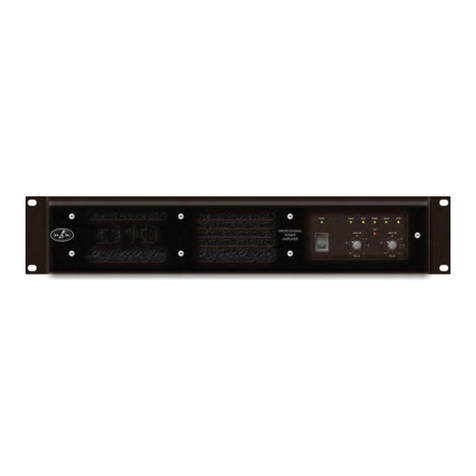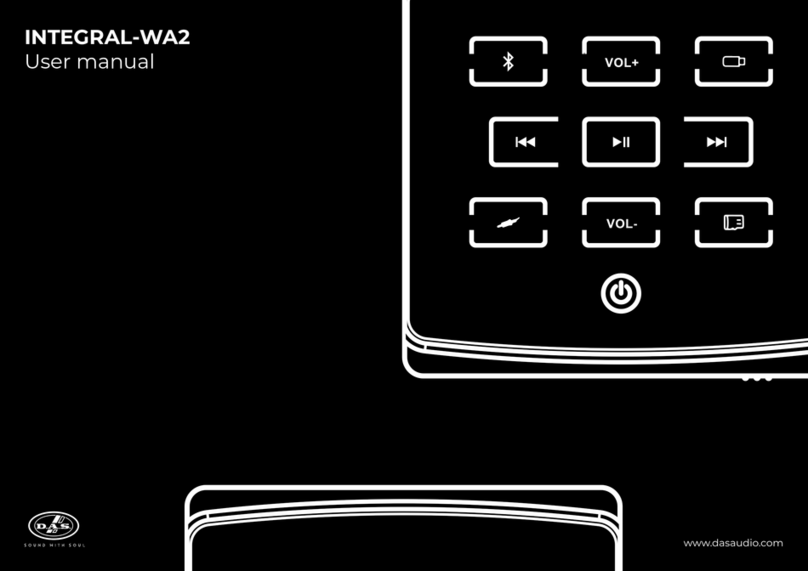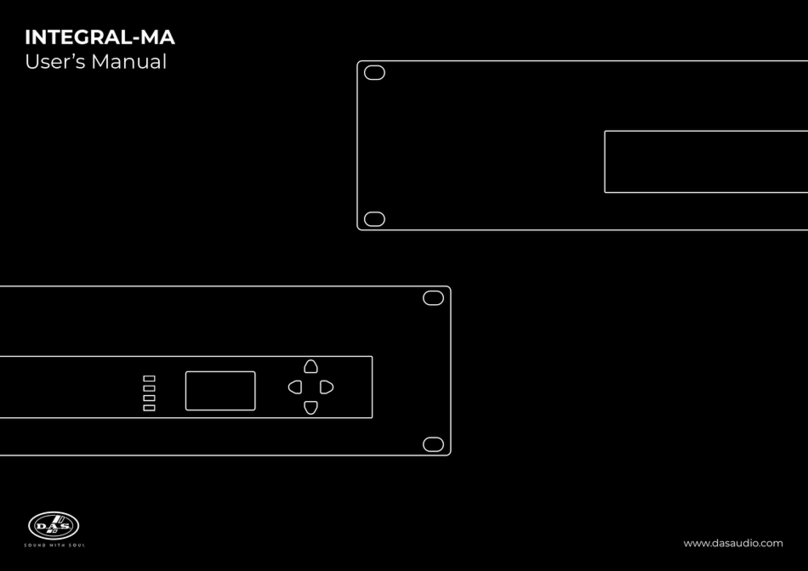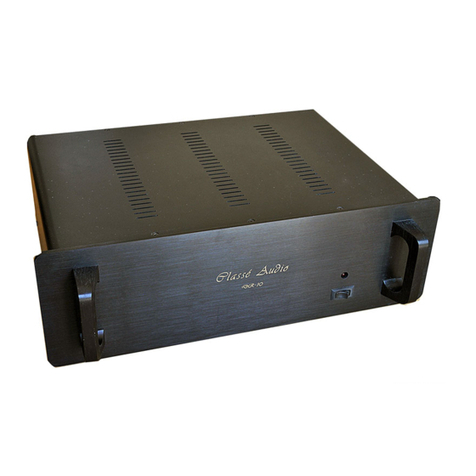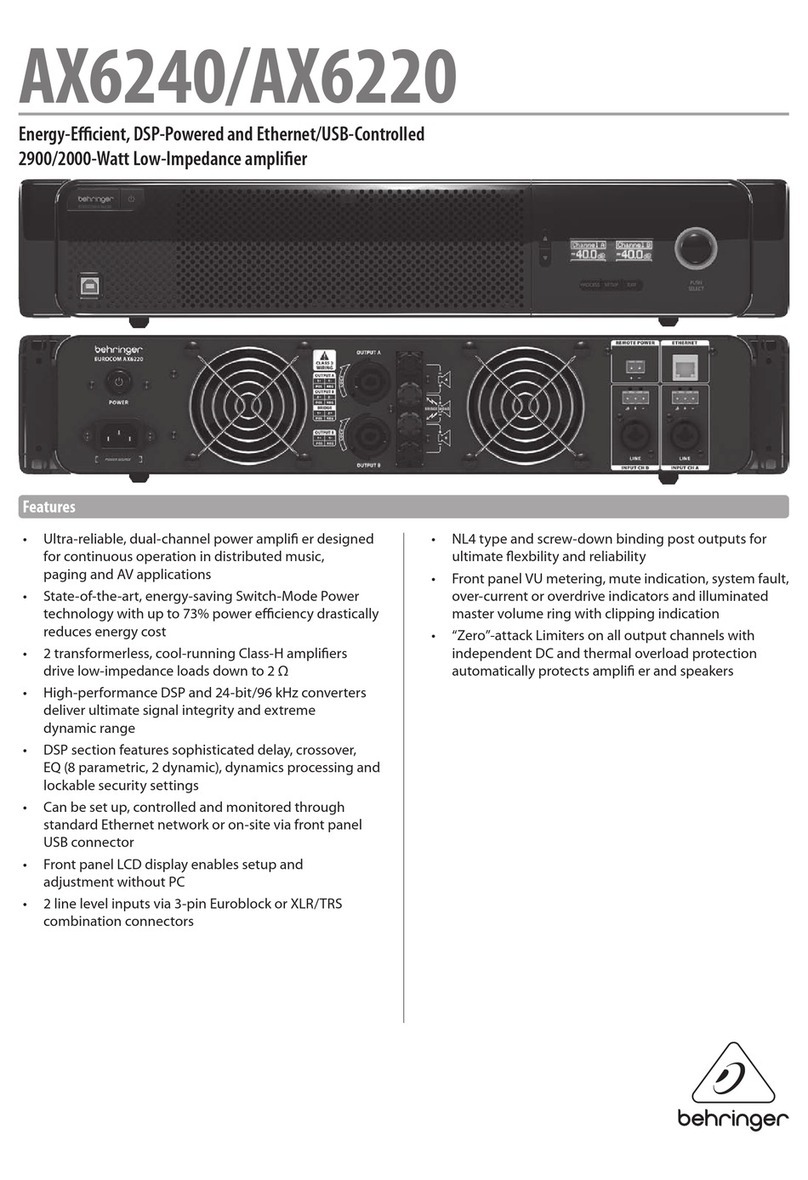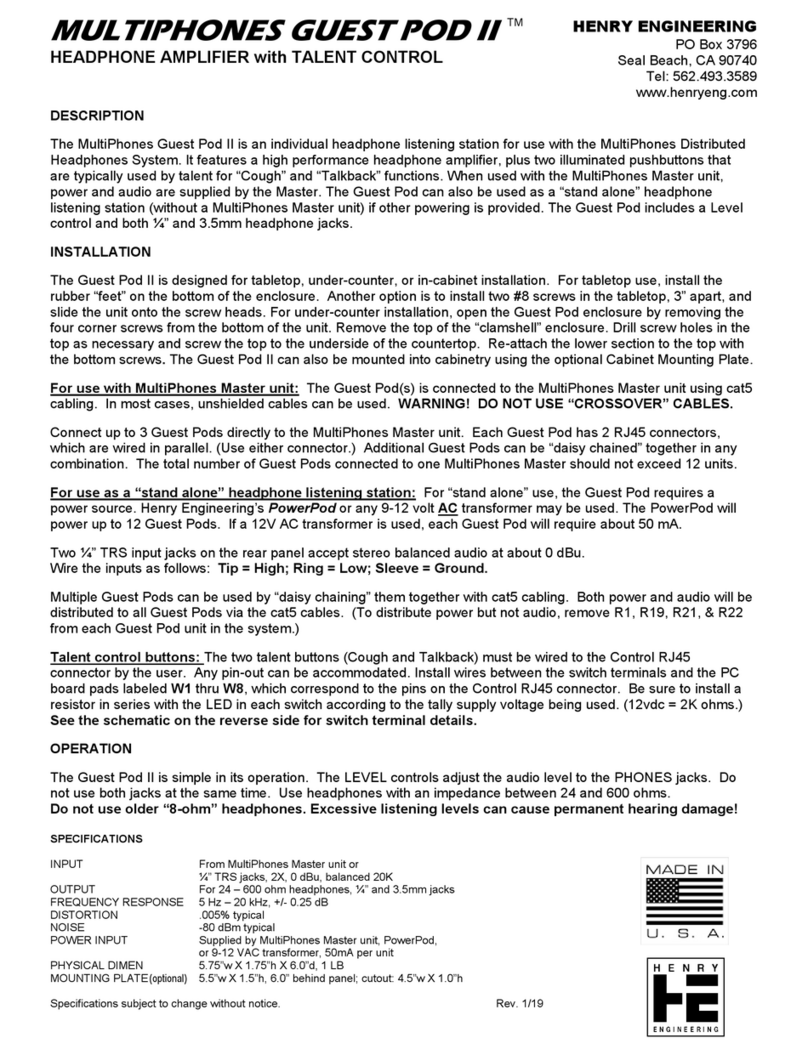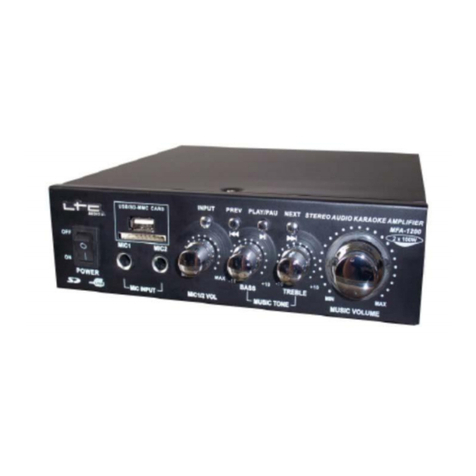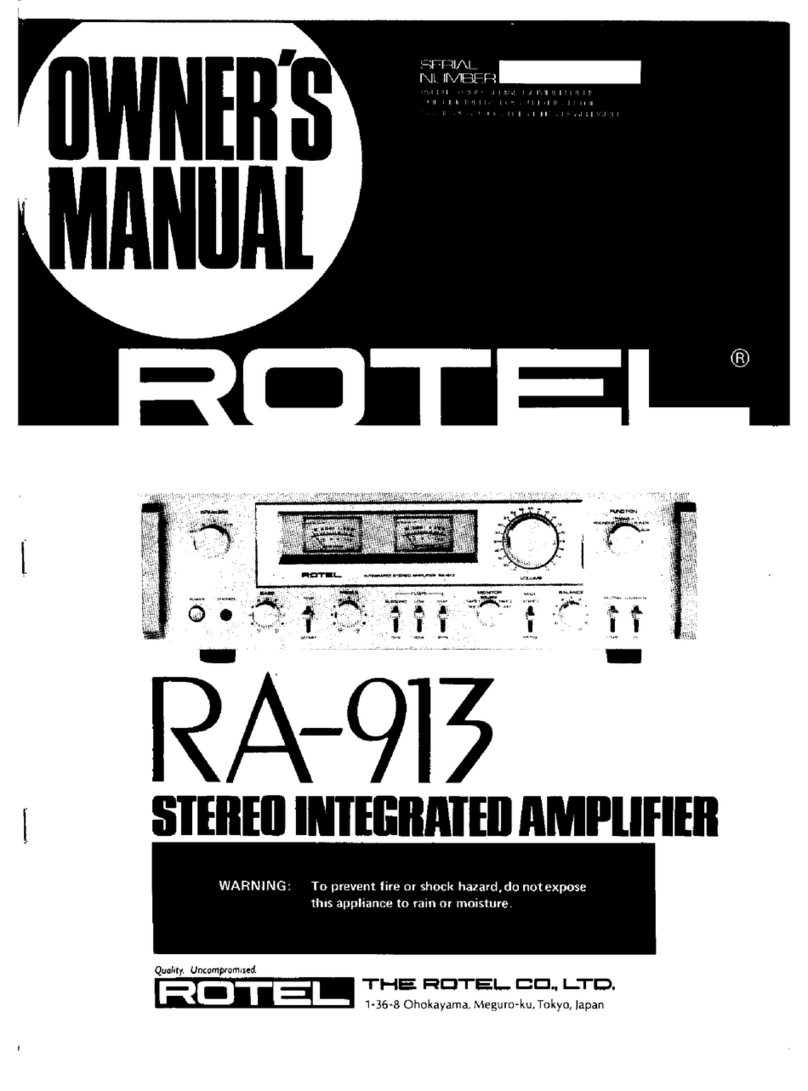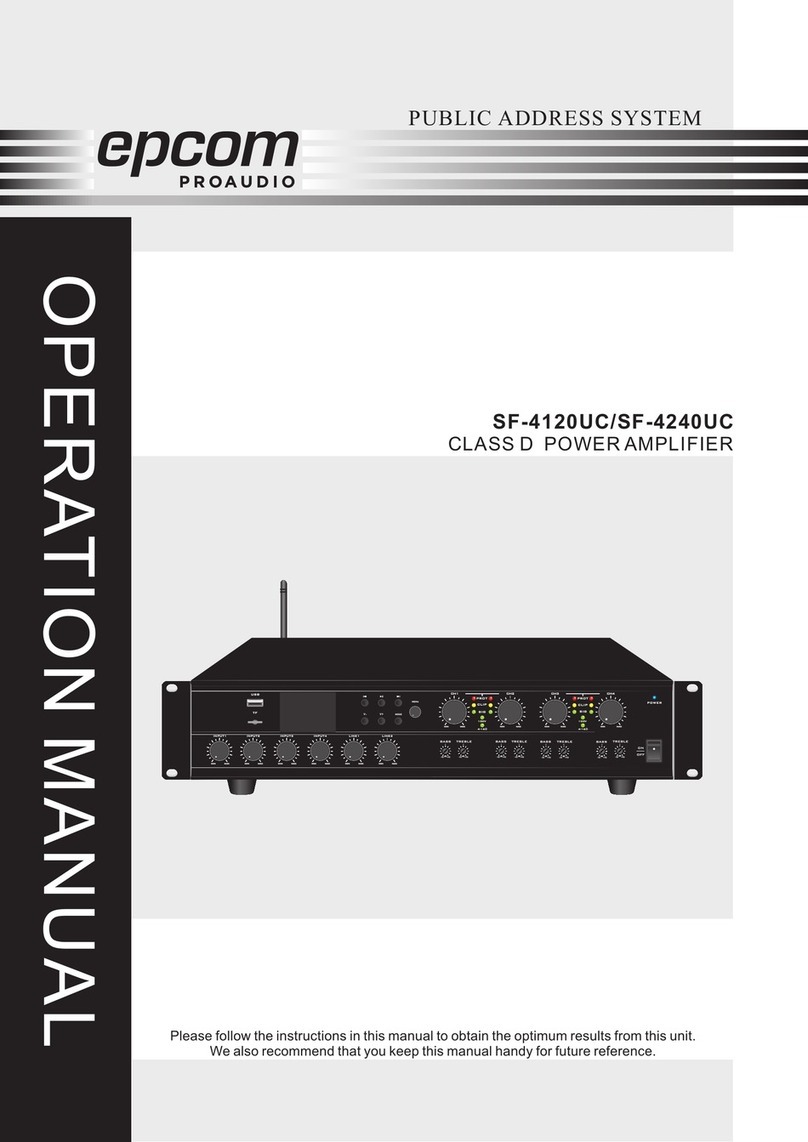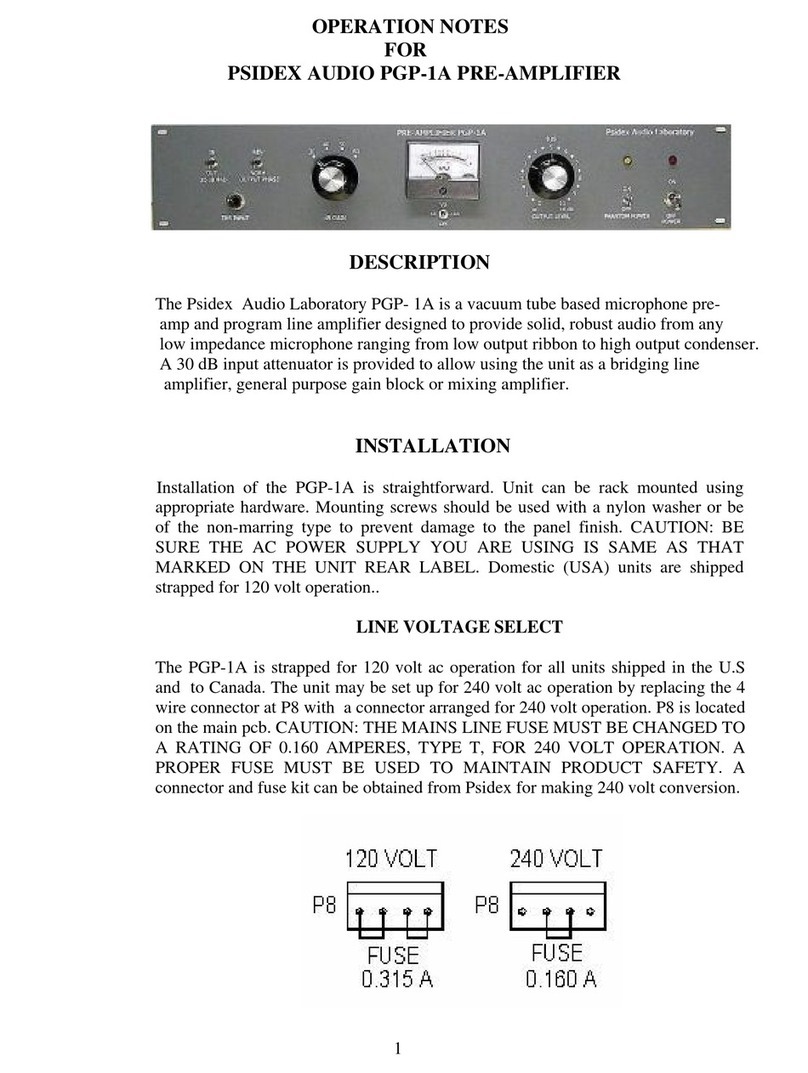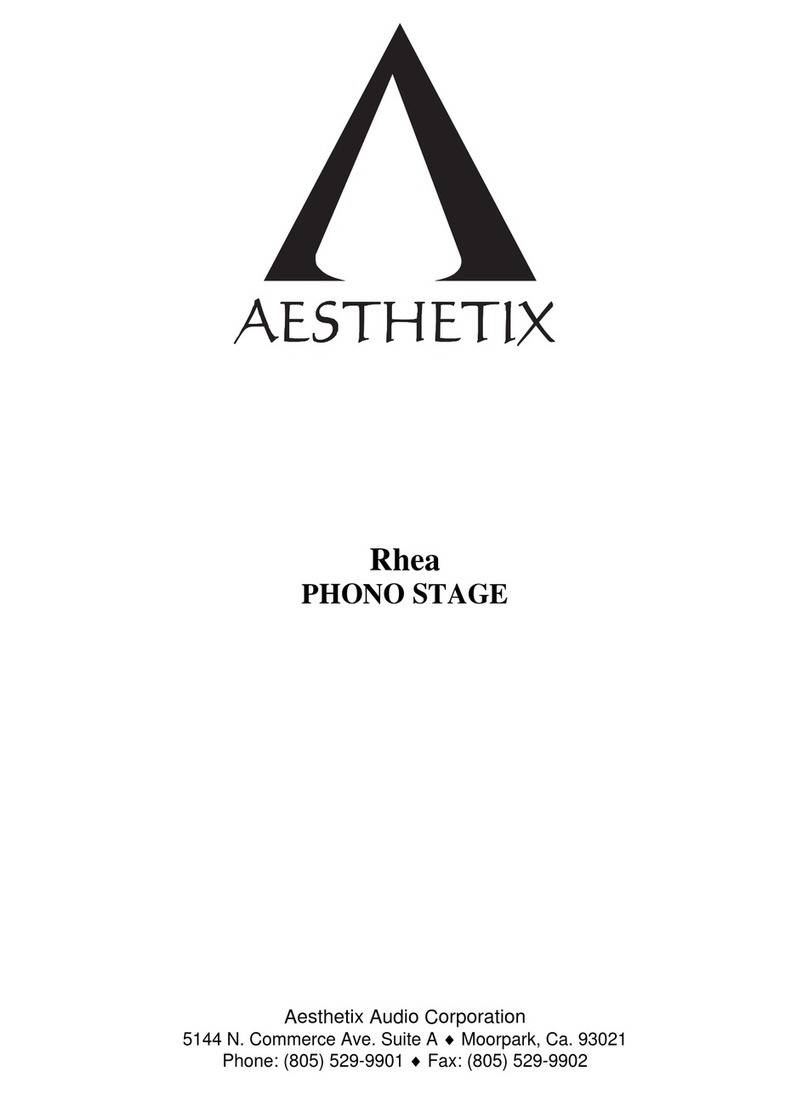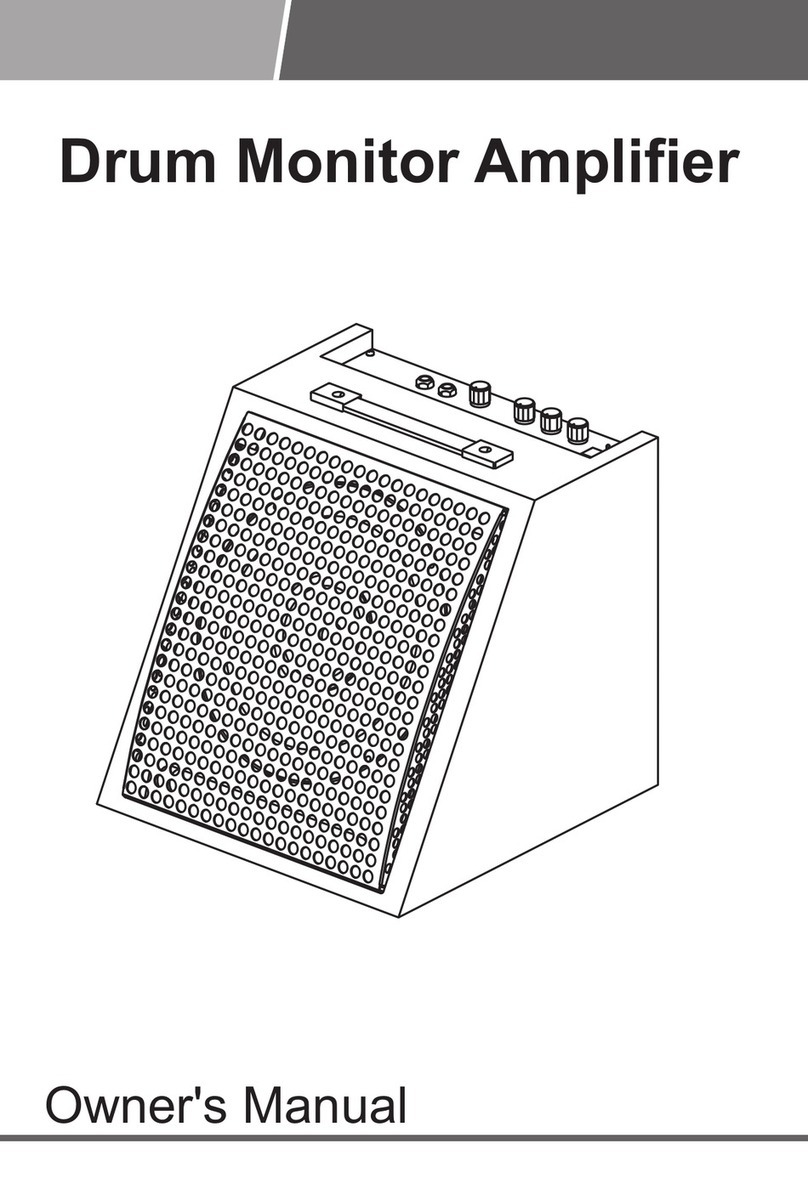DAS AUDIO SOUND E11EVEN DX Series User manual

User's Manual
DX series - Amplifiers
Before operating the device, please read the “Safety precautions” section of this manual.
www.11sound.com
Deliver the Nightclub Sound Experience we all Deserve

CONTENTS
SAFETY PRECAUTIONS
DECLARATION OF CONFORMITY
WARRANTY
INTRODUCTION
UNIT OVERVIEW
E11EVEN-NET CONTROL SOFTWARE
3
4
5
6
7
8
9 - 18
PRESET RECALL
CREATING A NEW PRESET
DEVICE PARAMETERS
ROUTING
INPUT EQ / OUTPUT EQ
DYNAMIC EQ (DEQ)
GRAPHIC EQ (GEQ)
SAVING THE FILE AND GOING ONLINE
10
11
13
14
16
18
20
21
LIMITERS
COMPRESSORS
LOAD OUTPUT CHANNEL
SETTINGS LOCK DEVICE
22 - 23
24
25
26-28
E11EVEN SOUND \ DX \ User’s Manual

CONTENTS
Acr836450391488-29588492.pdf 1 24/7/20 14:41
SAFETY PRECAUTIONS
DECLARATION OF CONFORMITY
WARRANTY
INTRODUCTION
3
4
5
6
INSTALLATION: ELECTRICAL CONSIDERATIONS
INSTALLATION: MECHANICAL CONSIDERATIONS
RF EMISSIONS
DYNAMIC AMPLIFIER PERFORMANCE MEASUREMENTS
INITIAL SET-UP AND SWITCHING ON
6
7
8
8
8
FRONT PANEL
REAR PANEL
9
10
MAINTENANCE
LINE INPUTS AND OUTPUTS
SPEAKER OUTPUTS
BRIDGED (MONO) OPERATION
10
11
11
12
SPECIFICATIONS 13
E11EVEN SOUND \ DX \ User’s Manual

3
Terminals marked with the lightning symbol carry electrical current of sufficient magnitude to constitute risk of electric
shock. Use only high quality cables with plugs pre-installed. All other installation or modification should be performed
only by qualified personnel. This symbol, wherever it appears, alerts you to the presence of un-insulated dangerous
voltage inside the enclosure - voltage that may be sufficient to constitute a risk of shock. This symbol, wherever it
appears, alerts you to important operating and maintenance instructions in the accompanying literature.
Please read the manual.
Caution:
To reduce the risk of electric shock, do not remove the top cover (or the rear section). No user serviceable parts inside.
Refer servicing to qualified personnel.
Caution: To reduce the risk of fire or electric shock, do not expose this appliance to rain and moisture. The apparatus
shall not be exposed to dripping or splashing liquids and no objects filled with liquids, such as vases, shall be placed on
the apparatus.
Caution: These service instructions are for use by qualified service personnel only. To reduce the risk of electric shock do
not perform any servicing other than that contained in the operation instructions. Repairs have to be performed by
qualified service personnel.
1. Read these instructions.
2. Keep these instructions.
3. Heed all warnings.
4. Follow all instructions.
5. Do not use this apparatus near water.
6. Clean only with dry cloth.
7. Do not block any ventilation openings. Install in accordance with the manufacturer’s instructions.
8. Do not install near any heat sources such as radiators, heat registers, stoves, or other apparatus that produce
heat.
9. Do not defeat the safety purpose of the polarized or grounding-type plug. A polarized plug has two blades with
one wider than the other. A grounding-type plug has two blades and a third grounding prong. The wide blade or the
third prong are provided for your safety. If the provided plug does not fit into your outlet, consult an electrician for
replacement of the obsolete outlet.
10. Protect the power cord from being walked on or pinched particularly at plugs, convenience receptacles, and
the point where they exit from the apparatus.
11. Use only attachments/accessories specified by the manufacturer.
12 . Use only with the cart, stand, tripod, bracket, or table specified by the manufacturer, or sold with the apparatus.
When a cart is used, use caution when moving the cart/apparatus combination to avoid injury from tip-over.
13. Unplug this apparatus during lightning storms or when unused for long periods of time.
14. Refer all servicing to qualified service personnel. Servicing is required when the apparatus has been damaged
in any way, such as power supply cord or plug is damaged, liquid has been spilled or objects have fallen into the
apparatus, the apparatus has been exposed to rain or moisture, does not operate normally, or has been dropped.
15. The apparatus shall be connected to a MAINS socket outlet with a protective earthing connection.
16. Where the MAINS plug or an appliance coupler is used as the disconnect device, the disconnect device shall
remain readily operable.
17. Correct disposal of this product: The wheeled bin symbol indicates that this product must not be disposed of
with household waste. Please refer to the WEEE page of this manual.
SAFETY PRECAUTIONS
E11EVEN SOUND \ DX \ User’s Manual

4
DECLARATION OF CONFORMITY
DAS Audio Group, S.L.
C/ Islas Baleares, 24 - 46988 - Pol. Fuente del Jarro - Valencia. España
(Spain) as E11EVEN Sound System´s supplier:
Declares that:
The following products: DX-80 & DX100
Are manufactured in accordance with EMC Directive 2014/30/EU, in compliance with the following
technical regulations: EN55103-1:2009, EN55103-2:2009 and in accordance with the Low Voltage Directive
2006/95/EC, in compiance with technical regulations: EN/IEC60065:2014
E11EVEN SOUND \ DX \ User’s Manual

5
WARRANTY
All our products are warrantied against any manufacturing defect for a period of 36 months from date of
purchase. The warranty excludes damage from incorrect use of the product.
All warranty repairs must be exclusively undertaken by the factory or any of its authorised service centers.
To claim a warranty repair, do not open or intend to repair the product.
All the details related to the warranty (such as extended warranties) can be found in the SUPPORT section
on our website: www.11sound.com
E11EVEN SOUND \ DX \ User’s Manual

6
INTRODUCTION
Thank you for choosing a DX series amplifier for your application.
Please spend a little time reading through this manual, so that you obtain the best
possible performance from the unit and become familiar with its operating requirements.
All DAS Audio Group products are carefully designed and engineered for cutting-edge
performance and world-class reliability. If you would like further information about this or
any other DAS Audio product, please contact us.
We wish you many years of service from this amplifier and look forward to hearing from
you in the near future.
The DX amplifier series has been designed to combine incredible audio power and
performance with ultra-flexible connectivity for both remote control and audio. Exemplary
audio processing is assured through the use of an external DAS's DSP, or of the DSP
platform in the DXi models, and power amplifier capabilities are taken care of with high
efficiency output stages and a generous power supply.
All units. DX-100 and DX-80, can include optional Dante networked audio.
Accepting analogue, or optional Dante networked audio, this extra connectivity means
that the DX models can also be used in installation systems which already have a
centralized DSP core but require the flexibility of being able to pick up multiple channels
of audio from a network.
With a range of power levels available in the DX series, the amplifiers can be networked to
a single DXi model, creating a powerful, efficient system that's easy to expand and adapt
for use in live, install and everything in between.
INSTALLATION: ELECTRICAL CONSIDERATIONS
The amplifier has been manufactured to comply with your local power supply
requirements, but before connecting the unit to the supply, ensure that the voltage
(printed on the rear panel) is correct.
The amplifier is fitted with either a 100/120V or 220/240V tapped transformer according to
customer requirements.
Make sure power outlets conform to the power requirements listed on the back of the
unit. Damage caused by connecting to improper AC voltage is not covered by the
warranty.
Safety Warning
Apparatus with CLASS I construction shall be connected to a MAINS socket outlet with a
protective earthing connection.
Where a MAINS plug or appliance coupler is used as the disconnect device, it should
remain readily operable.
Where the amplifier is mounted in a rack and permanently connected to the mains, then
the rack should be installed with a readily accessible connector or an ALL POLE circuit
breaker with 3mm breaking distances.
This unit is fitted with a 3-wire power connector. For safety reasons, THE EARTH LEAD
SHOULD NOT BE DISCONNECTED IN ANY CIRCUMSTANCE. If ground loops are
encountered consult the section on Line Inputs and Outputs on page 11.
E11EVEN SOUND \ DX \ User’s Manual

7
WHERE A FIXED MAINS LEAD IS FITTED, THE WIRING COLOURS ARE:
120V AREAS:
EARTH =
230V AREAS:
GREEN AND YELLOW GREEN
NEUTRAL = BLUE WHITE
LIVE = BROWN BLACK
TO PREVENT THE LIKELIHOOD OF SHOCK OR FIRE HAZARD, DO NOT EXPOSE THE UNIT TO RAIN
OR MOISTURE. DO NOT PLACE OBJECTS CONTAINING LIQUID ON TOP OF THE APPARATUS.
TO AVOID ELECTRICAL SHOCK DO NOT REMOVE COVERS. REFER ALL SERVICING TO QUALIFIED
PERSONNEL.
DO NOT USE THE UNIT OF THE ELECTRICAL POWER CORD IS FRAYED OR BROKEN. The power
supply cords should be routed so that they are not likely to be walked on or pinched by items
placed upon or against them, paying particular attention to cords and plugs and the point where
they exit from the appliance.
ALWAYS OPERATE THE UNIT WITH THE AC GROUND WIRE CONNECTED TO THE ELECTRICAL
SYSTEM GROUND. Precautions should be taken so that the means of grounding of a piece of
equipment is not defeated.
DO NOT REMOVE THE LID. Removing the lid will expose you to potentially dangerous voltages.
There are no user serviceable parts inside.
ESD strikes to the unit's front panel that are in excess of 4000 volts may cause disturbance to the
status LEDs on the unit. This will not affect audio performance and will be corrected on the next
power up cycle.
INTRODUCTION (cont'd)
INSTALLATION: MECHANICAL CONSIDERATIONS
To ensure that this equipment performs to specification, it should be mounted in a suitable rack
or enclosure as described below. Like all high power amplifiers, it should be kept away from
other equipment which is sensitive to magnetic fields. Also, this amplifier may suffer a
substantial reduction in performance if it is subjected to, or mounted close to equipment which
radiates high RF fields.
Warning: To prevent injury, this apparatus must be securely attached to the rack in accordance
with the installation instructions.
When mounting the amplifier in a rack or enclosure:
THE FRONT PANEL IS NOT CAPABLE OF SUPPORTING THE UNIT ON ITS OWN.
Make sure that the rear of the unit is adequately supported. The brackets which are supplied fit
standard 19 inch (483mm) rack mounting systems.
ENSURE THERE IS ADEQUATE VENTILATION.
The cooling fans suck cool air in through the front and blow hot air out at the rear of the unit
through the ventilating grills. The front and rear of the amplifier should have free exposure to the
air (i.e. in a rack leave the front & rear doors off), with 2cm air gap at the sides.
IF AIR IS NOT ALLOWED TO ESCAPE FROM THE REAR, OVER-HEATING WILL OCCUR.
Take care when mounting other equipment in the same rack.
Make sure that the rack unit has a separate earth connection (technical earth). Please also see the
notes regarding maintenance on page 10.
E11EVEN SOUND \ DX \ User’s Manual

RF EMISSIONS
The high frequency resonant converters in the DX series amplifiers have been designed to have
very low radio frequency (RF) emissions; however even these low level emissions can cause
interference with other equipment.
In order for this to be minimised, the amplifier should be mounted in a metal rack enclosure,
which should have a separate (technical) Earth. Alternatively a separate earth should be
attached to the amplifier at the rear rack mounting bracket.
DYNAMIC AMPLIFIER PERFORMANCE MEASUREMENTS
The DX series is the very latest example of a 'dynamic amplifier'. This new 'breed' of power
amplifiers provide very high peak power levels in a much smaller, and lighter, package than
previously possible with conventional amplifiers.
They are designed specifically for today's high power audio installations, which use multiple
speakers with electronic crossovers or speaker controllers. These systems can handle very high
transient signals that far exceed their RMS power rating. The DX series amplifiers have been
designed to match this requirement and can deliver huge levels of power for short durations.
In order to protect themselves and the loudspeakers that they are driving, continuous signals
such as sine waves, are automatically detected and reduced (ramped down) to a safe level.
When trying to measure the power output however, continuous signals will give totally incorrect
results. A dynamic signal, such as a tone burst, should be used and the levels measured by
monitoring the waveform on an oscilloscope. The power envelope can then be accurately
measured.
Our power output figures are measured using signals with known Crest Factors and are quoted
at the rear of this manual on page 43 and on our website.
Please refer to the technical area of our website for further information.
INITIAL SET-UP AND SWITCHING ON
Please read all documentation before operating your equipment and retain all documentation
for future reference.
Do not spill water or other liquids into or on the unit and do not operate the unit while standing
in liquid.
Do not block fan intake or rear ventilation outlets or operate the unit in an environment that
could impede the free flow of air around the unit.
If the unit is used in an extremely dusty or smoky environment, it should be cleaned of any
collected debris at regular intervals. Please also see the notes regarding maintenance on page
10. It is important that the power output of your amplifier is matched to the power handling
capacity of your loudspeaker. If not, damage to the loudspeaker could occur.
Switching On…
At 'switch-on' the protection circuit will initially activate whilst the circuits stabilise, indicated by
the red A/P LED illuminating, in addition to various other LEDs. After a few seconds the red A/P
LED will extinguish indicating a satisfactory working condition. Other LEDs may remain
illuminated depending upon rear panel switch settings and input connections. If the A/P LED
does not extinguish after 5 seconds the unit may be faulty or some external connections may be
incorrect or inappropriate. If this occurs you should power down the unit and remove all external
connections (except for the mains power supply) and repeat the power up sequence. If the
problem persists please contact us.
E11EVEN SOUND \ DX \ User’s Manual
8

FRONT PANEL
PROTECTION
BRIDGE 1+2
BRIDGE 3+4
POWER
LIM LIM LIM LIM
3 3 3 3
6 6 6 6
12 12 12 12
18 18 18 18
24 24 24 24
LINK LINKLINK
-12 -12 -12 -12
-6 - 6 -6 -6
-20 - 20 -20 -20
-4 -4 - 4 -4
-2-2-2-2
0dB 0dB 0dB 0dB ANALOGUE
NETWORK AUDIO
DX SERIES
STBY
- - - -
2
1
6
10 11
5
9
8
3 4
7
Note: The front panel is common for all models.
1: Analogue level controls: These function in both analogue input and network audio input mode.
2: Signal meters: These will show the level of the respective amplifier's output channel. The red LED
in the meter will illuminate when the limiter threshold has been reached and limiting is occurring.
3: Link LED: This indicates if the channel is linked to its immediate neighbour. If this is illuminated,
the attenuation control of the channel to the immediate right will not function as both channels
are being fed from the left hand channel. Linking is disabled in Network Audio mode and Link LEDs
will be extinguished.
4: PROTECTION LED: If a condition exists, either internally or externally, that could cause damage to
either the amplifier or the speakers, the protection circuit will disengage the outputs and this LED
will illuminate/flash.
Typical conditions that could cause the protection to be triggered include very high frequency or
subsonic input signals, DC in the inputs, short-circuited outputs, or internal high temperatures.
The protection circuit can affect all channels or a 'channel pair' depending on the type of fault. This
is indicated by the combination of Protection LED illuminating and a corresponding message on
the LCD. In this way, it is possible for two channels (a channel pair) to remain functioning even
though a fault has caused the other channel pair to mute. A channel pair would be 1+2 or 3+4.
Temperature related faults will reset automatically if the unit has cooled sufficiently. Output short
circuits will require manual reset after clearing the fault (switching off at the mains switch and then
on again after a few seconds). Short circuits on either channel of a channel pair will only affect that
channel pair.
5,6: BRIDGE pair LEDs: The channel pair LED will illuminate if these channels have been switched
into bridged (mono) mode. See page 11 for details of how to connect your speaker to a bridged
channel pair, and page 12 for how to enable bridge mode.
7: STBY LED: The DX amplifiers can be powered down leaving just the input circuitry and Dante
network audio card (if fitted) active. This LED illuminates when the power amplifier sections are
turned OFF.
8: Power Switch: This double pole switch turns the amplifier fully off and isolates it from the mains
supply.
9: POWER LED: This will illuminate when the Power Switch is ON. It is not an indicator of connected
supply.
10: ANALOGUE LED: This illuminates when the selected source is the four input XLRs.
11: NETWORK AUDIO LED: This will illuminate when the selected source is the network audio
connection.
E11EVEN SOUND \ DX \ User’s Manual 9

10
REAR PANEL
Al l vents on fr ont and rear of unit must not be obstructed.
Tous
les
passages
sur
avant
et
ar ri ère
de
l' unité
ne
doi vent
pas êtr e obstrués.
OUTPUT
Class 3
Wiri ng
on Outputs
1
-
AUDIO
NETWORK
- 2
OUTPUTOUTPUTOUTPUT OUTPUT
WIRING
CONNECTORS
BRIDGE
1+
1-
2+
2-
PIN NUMBER
BRIDGE
3+4
BRIDGE
1+2
INPUT
LINK
INPUT
LINK
INPUT
LINK
SOURCE
SELECT
4 5
1
2
6
3
7
8
SERIAL
NO.
Note: Designed and manufactured in England by MC Audio for DAS Audio Group, S.L. The rear
panel is common for all models.
1: Fan outlet: The variable speed fans suck air in through the front vents and out through the back
of the amplifier. Please see maintenance for recommendations on how to clean this and the front
foam sections.
2: Channel output Speakon socket: Normal output is on pins 1+ hot, 1- cold. Channel B's output is
also wired to this socket to enable a single NL4 to provide both channels and to facilitate easier
wiring in bridged mode. Channel B is wired pins 2+ hot, 2- cold. Similarly channel C's output
Speakon socket carries Channel D's output. Check the table on the rear panel for details.
3: Audio network connections: Four additional inputs can be added to the available input choices
via the optional Dante network card.
4: Source select switch: This selects either the four analogue input XLRs or the output of the
network audio card as the audio source. It operates globally across all four channels.
5,8: Bridged (mono) switch (3+4)/(1+2): Press this switch to run this pair of amplifier channels in
bridged mode. To run 1+2 bridged, press the switch on the far left of the panel, beside channel A's
input XLR.
6: Link switch: Press this switch to link the input of the channel to its immediate left. Multiple
channels may be linked using these switches so, for example, to link all outputs to input A, press all
three switches IN and use input A only. The front panel attenuators will still operate independently
when channels are linked. Linking is disabled in Network Audio mode and Link LEDs will be
extinguished.
7: Input XLR sockets: Connect signal inputs to these sockets, wired pin 2 hot, 3 cold, 1 ground. For
sensitivity and impedance of these inputs, please see the specifications on page 14.
MAINTENANCE
These maintenance instructions are for use by qualified personnel only. Before any routine
maintenance, please ensure that your amplifier is disconnected from the mains supply!
The filter behind the air intake apertures on the front of your amplifier should be cleaned or
replaced periodically, e.g. 12-24 months. (Filters in amplifiers located in more 'dirty' atmospheres
may require more frequent maintenance).
The filter should be 'dry' cleaned, using a vacuum cleaner preferably. Running the unit without a
filter is not recommended unless it is within a 'clean room'. Replacement filter material is available.
If the fan vents on the rear of the amplifier develop a build-up of dust/debris on the finger guards,
they can be cleaned with a dry paintbrush and a vacuum cleaner.
The casework of the amplifier may be cleaned with a lightly dampened cloth – do not use any
solvents as they will damage the paint finish and could remove printing.
If you have any doubts about carrying out maintenance, please refer to a service engineer or
contact your local dealer.
E11EVEN SOUND \ DX \ User’s Manual

11
REAR PANEL (cont'd)
VLR
MALE
QPEAKON
NL2 & NL4
LINE INPUTS AND OUTPUTS
The inputs are made via 3-pin XLR connectors,
which are electronically balanced and should be
connected via a high grade twin core screened
cable, as follows:
Pin 1: Screen (see note below)
Pin 2: Hot (signal +)
Pin 3: Cold (signal -)
The amplifier is designed to operate with fully balanced equipment and ground loops or loss
of performance may be experienced if connected to unbalanced sources. If it is unavoidable
however, the following wiring should be used. The cable should still be twin core plus screen.
Pin 1: Screen - connected to the chassis of the unbalanced equipment - or left disconnected
at the unbalanced end.
Pin 2: Hot (signal +)
Pin 3: Cold (ground 0V)
NOTE: This amplifier is wired to the latest industry recommendations. Pin 1 is connected
directly to the chassis/mains earth. If ground loops (mains hum) are encountered remove
the screen connection from the other end of the cable and leave it open circuit. If problems
persist, consult your dealer/supplier.
DO NOT TAMPER WITH OR ALTER ANY GROUND (EARTH) CONNECTIONS INSIDE THE
AMPLIFIER.
For bridged operation input should be made to channel A (or C) only and the channels set
for bridged mode for the appropriate pair of channels.
SPEAKER OUTPUTS
The speaker outputs are via Neutrik Speakon connectors. 2 pole (NL2FC) or 4 pole (NL4FC)
connectors can be used.
Pin 1+: Hot
Pin 1-: Cold
Additionally, Channel 1 Speakon connector carries Channel 2 output on Pins +2 & -2 to allow easy
bi-amping or bridged operation using a single NL4 connector. Similarly, Channel 3's Speakon
connector also carries Channel 4 output.
Output Connector 1
Pin 2+: Hot Ch. 2
Pin 2-: Cold Ch. 2
Output Connector 3
Pin 2+: Hot Ch. 4
Pin 2-: Cold Ch. 4
E11EVEN SOUND \ DX \ User’s Manual

12
REAR PANEL (cont'd)
For bi-amped operation, connect as above.
There must be no shared connections between channels.
Negative output terminals must not be joined together as they are not both at ground potential.
Connecting them together will damage the amplifier and void the warranty!
As the currents involved are very high, and to ensure best performance, the speaker cables
should be kept as short as possible and conform to the following minimum requirements:
DX-80, 14A into 4 Ohm speaker loads
DX-100, 20A into 4 Ohm speaker loads
When operating the amplifier into loads of less than 4 Ohms, be aware that the current capacity
of the speaker cables will need to be increased above the values quoted here.
Do not connect the inputs/outputs to any other voltage source such as a battery, mains source
or power supply, regardless of whether the amplifier is turned on or off.
Do not run the output of any amplifier channel back into another channel's input and do not
parallel or series-connect an amplifier output with any other amplifier output.
BRIDGED (MONO) OPERATION
Pairs of channels may be independently bridged – channel pair 1+2, and/or channel pair 3+4. The
method is the same for both channel pairs:
Use Channel 1 or 3's Output Speakon connector and connect as follows:
Pin 2+: Hot
Pin 1-: Cold
When operating in bridged mode, the minimum impedances are doubled.
The minimum load in bridged mode is 4 ohms.
E11EVEN SOUND \ DX \ User’s Manual

SPECIFICATIONS
Main Specifications
Parameter [Units)
X X X X
X X X X
X X X X
Additional Specifications
Parameter [Units)
13
Due to continuing product improvement, the above specifications are subject to change.
E11EVEN SOUND \ DX \ User’s Manual

SPECIFICATIONS (cont'd)
Power Consumption and Thermal Emissions - DX-80
(VI IR] (Al (W]
No Sig'l Light erage Heavy No Sig'l Light Avege Heavy
240 8
240 4
240 2
120 8
120 4
120 2
Power Consumption and Thermal Emissions - DX-100
(V] IR] (Al
(W]
No Sig'l Light erage Heavy No Sig'l Light erage Heavy
240 8
240 4
240 2
120 8
120 4
120 2
No Sig'I = Quiescent, Light = Crest Factor of 7.8(18d8),
Average = Crest Factor of 4.8(14d8), Heavy = Crest Factor of 2.8(9d8)
For details of measurement methods please refer to the Technical Support area of our website.
14 E11EVEN SOUND \ DX \ User’s Manual

www.11sound.com
This manual suits for next models
2
Table of contents
Other DAS AUDIO Amplifier manuals
